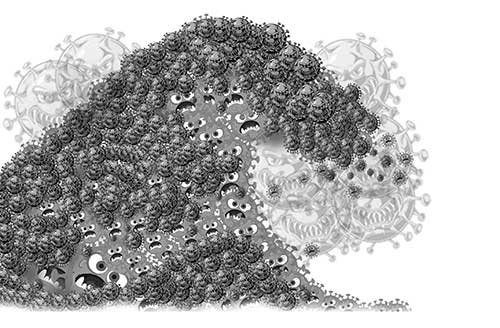Opinion
No second wave in China – Lessons for the World

The US and several countries in Europe are battling a second wave of Covid-19, while several others seem to have succeeded in beating down the second wave effectively. And the virus strain involved in the second wave in all these countries seems to be similar and could be the strain known as G614. In the USA, this virus at present is causing more than 100,000 cases per day, and globally one million every three days. How is it that countries like China, Vietnam, Hong Kong, Australia, etc., have emerged almost unscathed from the second attack by the same virus strain, which is said to be 10 times more infectious than the first wave strain? There may be two reasons. First, the efficiency and commitment of the authorities and second, the people’s commitment and cooperation.
A comparison of the number of cases at peak levels in daily incidence in the first and second waves in France and the UK would give an idea about the relative infectiousness of the two strains. In France the number of cases at peak level in April was 7,300 and in October it was 26,000. Corresponding figures for the UK were 7,800 and 17,000. In contrast, Vietnam had less than 5000 total cases in the first wave with hardly any deaths, and 1200 in the second wave with few deaths. And Vietnam’s health services are not better than those of Sri Lanka.
An epidemiological comparison of the first and second waves in China would be revealing, and shows the contrast between the impact of two cultures on the pandemic. The Covid-19 started in China, and the country recorded more than 80,000 cases and about 4000 deaths. It was quickly brought under control, and a second wave in June which, however, could hardly be called a wave in the context of such a massive sea of people, recorded 318 cases with no deaths.
The most recent outbreak in China in October was in Qingdao in the Eastern Shandong Province, which had a mere 12 new cases. The secret of success here was the immediate lockdown of the province at the first signs of infection, and placing the surrounding provinces on a war footing together with mass testing. These measures have allowed China’s economy to recover quickly while controlling the pandemic. Leading respiratory physician in the fight against Covid in China, Zhong Nanshan, says China is unlikely to have a second wave of the infection in the coming winter because of comprehensive and strict prevention and control measures. Wu Zunyon, chief epidemiologist at the Chinese Centre for Disease Control and Prevention, says that the recently concluded National Day holidays from Oct. 1st – 8th, which had 637 million domestic tourists with no signs of infection, is a test of success of the measures taken for prevention from the beginning. He says there is no possibility of a second wave.
The governments in China and Vietnam and also their people are fully committed to the mission of eradicating their countries of the scourge of Covid-19. They are innovative and generous too. Rich look after the quarantined poor with food known to improve immunity and traditional medicine. Vietnam carried out massive testing by means of pooled sample testing, where 100,000 people could be tested with 20,000 sample tests. If a particular pooled sample is positive, everybody in that pool would be tested. This method is quick and cheaper.
When Melbourne, Australia’s cultural city, was hit hard by a second Covid wave, officials moved swiftly and a strict lockdown was clamped which lasted 110 days! The measures adopted were described as “controversial, calamitous for jobs, and crushingly hard for many”. Yet people were not allowed to starve, distribution of food was efficiently carried out, and daily wage earners were looked after by an excellent welfare system. They have come out of it with minimum damage. Australia has been added to the list of countries held as models for prevention and management of Covid-19.
The people in these countries send a strong message to the rest of the world. The clear message is that they are not prepared to “live with Covid”, which seems to be the idea gaining ground in Sri Lanka, too, at present. Further, it’s a lesson about what could be achieved by genuine commitment, efficiency, innovation, generosity, culture, ethics and good behaviour.
In contrast, in the USA President Trump’s flippant and clownish behaviour and his attempt to take lightly the danger of the infection, had given the people the wrong message which has proved to be disastrous. He predicted the virus will vanish when the sun shines. He recommended anti-malarial drugs, and attempted to treat patients. He ridiculed Dr. Anthony Fauci, Director of the National Institute of Allergy and Infectious Disease, USA, in public. He condemned the WHO and withdrew US support for it. He called the Covid virus the “Chinese virus” and accused China of purposely releasing the virus into the world and engaging in biological warfare, in his address to the UN, and six days later contracted the disease himself. And the pandemic became worse with more than 100,000 being infected daily.
People in these countries are no better, they riot against lockdowns and gather on the beaches claiming that it is their right. They attend Trump’s campaign meetings without masks or maintain physical distancing. And worse, they voted for Trump in their numbers! What an insane society! Erich Fromm the great social scientist wrote about these matters in his famous work titled “Sane Society”. Perhaps, Sri Lanka too has lessons to learn from all these happenings.
N. A. de S. AMARATUNGA